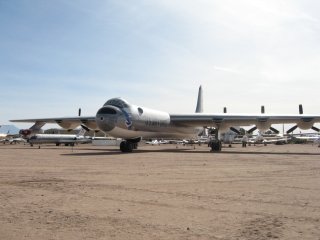There's Good Reason Why You've Never Heard of the NB-36 Bomber
While nations like Russia continue to struggle with fielding nuclear-propulsion in missiles, the United States was already testing a nuclear-powered bomber all the way back in 1955, in the form of the massive Convair NB-36 Crusader.
The NB-36 Crusader made 47 recorded flights with its reactor onboard
Related: AMERICA’S AIR-TO-AIR NUKE WOULD HAVE TAKEN OUT ENTIRE BOMBER FLEETS
Because the HTRE-3 propulsion system was designed to function under chemical power before and after leveraging its nuclear reactor, the system was perfectly suited for test flights that relied entirely on that chemical fuel while testing the reactor’s operation in flight.
The NB-36 Crusader first took to the skies in 1955, followed closely by several support planes keeping close tabs on the nuclear-powered bomber as it flew over a barren test range in New Mexico. One of those planes carried U.S. Army paratroopers who were tasked with the unenviable job of immediately securing the area in the event of a crash.
In each flight, the NB-36 would take off and fly using chemical propellant, with the reactor then powered on as though it would be providing propulsion. Convair and the Air Force monitored the reactor’s performance relentlessly, collecting data about power output, stability, and the safety of the crews on board. In total, the NB-36 Crusader spent some 215 hours in the skies over New Mexico and Texas and flew for a total of 89 hours with the nuclear reactor at full burn, proving without a doubt that a bomber could fly while running producing nuclear energy onboard.
But as potent a weapon as a nuclear-powered bomber could be, the world was changing around the NB-36 by the time it was flying.
Killed by ballistic missiles
By 1959, the United States was already fielding the SM-65 Atlas intercontinental ballistic missile, which was also developed by Convair. The SM-65 had a range of nearly 9,000 miles and required no aircrew for delivery. A year later, the USS George Washington (SSBN 598) successfully test-fired the first Polaris A1 Fleet Ballistic Missile with an operational range of a thousand miles. Suddenly, the United States had both ground and sea-based alternatives to its still maturing Crusader.
Related: PROJECT PLUTO: THE CRAZIEST NUCLEAR WEAPON IN HISTORY
The NB-36 could have been the world’s first and only operational nuclear-powered bomber, but despite the tests proving that nuclear propulsion was feasible, it still just wasn’t very practical. Like other programs that relied on nuclear propulsion (including the positively insane Project Pluto that would have spewed radiation out the back as it lobbed atomic bombs at targets along a pre-programmed course), the risk of nuclear propulsion simply outweighed its practical value. At least, it did when there were more conventional alternatives that could do the job as well or better.
Capable as the NB-36 may have been, any crash could have quickly resulted in a nuclear incident, making it a questionable choice for flight operations over U.S. soil. It would have almost certainly also raised eyebrows among allies and enemies alike if the United States were to commence patrols with it in or near foreign airspace. Had it offered some capability that was as essential as it was unique, that political and diplomatic strife may have been worth it, but it simply wasn’t with missile stockpiles beginning to form.
In 1961, President John F. Kennedy officially canceled the NB-36 Crusader program, and with it, America’s dreams of fielding a nuclear-powered bomber.
This article first appeared at Sandboxx.
Image: Flickr

